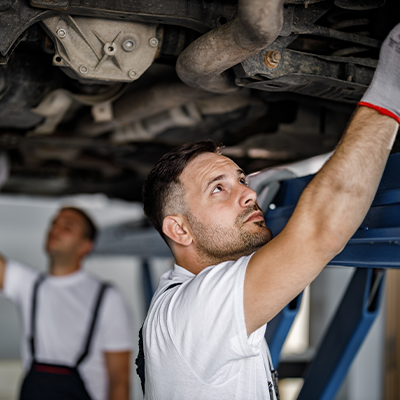- Home
- Services
- Suspensions
- Wheel bearing replacement
Wheel bearing replacement

The wheel bearings allow the wheels to turn freely and keep them in the right position set by the suspension and the steering gear. The bearings wear with time, usually as a result of driving over bumpy roads. If you hear a distinct humming noise that increases as you accelerate, it most likely means that your wheel bearings need replacing. Ignoring a wheel bearing failure may compromise the efficiency of the braking system and cause damages to it.
Tips
- The bearings should be replaced in pairs
- After replacing the bearings you should have their play adjusted by means of the half-shaft castle nuts
- The castle nuts should be replaced together with the bearings
Scope of services
- Removing the wheel with the failed bearing
- Removing the brake clamps, the anchor and the disc
- Removing the half-shaft castle nut
- Pushing the bearing out of the knuckle
- Fitting a new bearing in
- Fitting a new half-shaft castle nut in
- Refitting the brake clamps, the anchor and the disc
Find a car workshop
Check out our workshops that offer the service wheel bearing replacement in some of the biggest cities in your country
Additional info about the service
What is the role of the wheel bearing?
The wheel bearing allows the wheel to rotate and keeps it in the position determined by the suspension and the steering system components. Wheel bearings gradually wear and require replacing.
When should wheel bearings be replaced?
You can tell that they need replacing by excess noise produced by the wheels, which becomes more intense as you increase the speed and less intense as you turn the wheel. The play of a worn bearing may have a destructive effect on the brake discs, brake pads, and, in extreme case, tyres.
How is a wheel bearing replaced?
Replacing a wheel bearing requires lifting the car, removing the appropriate wheel and brakes, i.e. the brake clamp, its anchors and the brake disc. Next, the central nut of the half-shaft is removed. A hydraulic press may have to be used to squeeze the bearing out of the steering knuckle. A new bearing is fitted in the reverse order.
What to keep in mind?
As the useful life of the bearings is similar, it is recommended that both bearings on one axle be replaced even if only one of them fails. After the replacement the bearing play has to be adjusted by means of the half-shaft crown nut. Remember to always use a new nut and to secure it in place as suggested by the manufacturer, i.e. by means of a pin or by bending a part of its collar. If you use one of the increasingly popular self-bending nuts, remember that it must not be reused.